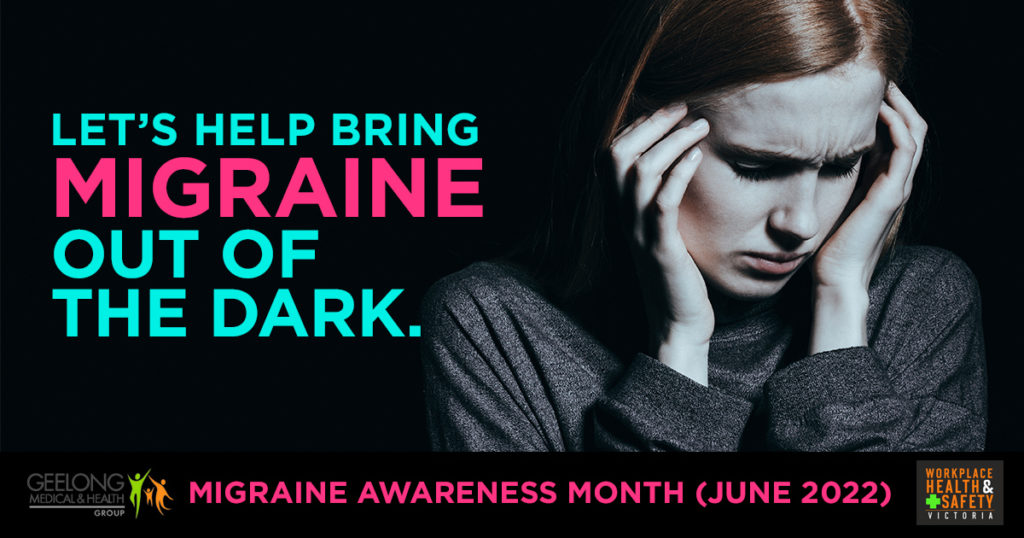Let’s Help Bring Migraine Out of the Dark
June 1 2022
Migraine Awareness Month (MAM) is a global event held in June each year. The aim is to raise awareness of migraine, reduce the stigma that migraine is ‘just a headache’ and promote a positive and empowering view of migraine and the migraine community.
The theme for MAM2022 is ‘Out of the Dark’. With over 5 million Australians living with migraine, we feel that it is time for migraine to come out of the dark and be treated by the government, health care professionals, researchers and the broader community with the respect and importance it deserves.
THE BASICS OF MIGRAINE
Migraine is a genetic, incurable, neurological disorder causing significant invisible disability among the population. Migraine is very common – it is estimated 4.9 million Australians live with migraine, 1 in 10 men and 1 in 3 women. Working-age women are the most significantly affected, with up to 45% of women between 25 and 45 experiencing migraine attacks. People living with migraine will move up and down the migraine spectrum during their lifetime. Women typically peak in severity in their 40s, men peak in their teens or older age.
ABOUT MIGRAINE DIAGNOSIS
Migraine is a complex condition with a range of presentations (see Types of migraine). There is no widely available or easy test; migraine is diagnosed symptomatically or by exclusion. Genetic testing through QUT is available for some types of migraine. It is common for people not to be properly diagnosed until their migraine attacks become frequent and debilitating. Many living with migraine don’t know they have it, and approximately 1 in 5 who know they have migraine have never sought treatment.
Migraine is frequently misdiagnosed as other headache diseases, multiple sclerosis (MS), irritable bowel syndrome (IBS), mental illness (especially anxiety) or a host of other conditions. There is no single ‘cause’ nor ‘cure’ for migraine attacks: you need to have the right genes to have migraine, and the attacks are ‘triggered’ by any combination of factors – hormones, diet, environment, stress, etc. It is not possible to fix the genes, nor remove all triggers: the best we can do is manage the condition.
TYPES OF MIGRAINE
Common or typical migraine is the bad headache, nausea, sensitivity to light, smell and sound, that many are familiar with.
Migraine with aura, also called classic migraine has all the symptoms of common migraine, with an additional ‘aura’ phase before the headache where many strange symptoms are experienced. Aura symptoms are usually one of the senses not working quite right (for example numbness or pins and needles, seeing colours or flashing lights, strange tastes).
Migraine Aura Without Headache (MAWH) involves all of the elements of a migraine attack without headache.
Hemiplegic migraine typically involves significant weakness and numbness is experienced on one side of the body. Paralysis to either part (such as a facial droop) or all of the side (which looks a lot like a stroke) can also happen.
Migraine with Unilateral Motor Symptoms (MUMS) is a similar sub type where motor weakness and paralysis is experienced on both sides of the body.
Migraine with brainstem aura (also brainstem migraine, previously called basilar type migraine) can involve visual disturbances, speech disturbances, hearing problems, weakness, vertigo, decreased consciousness, and in the most severe attacks, coma.
Retinal migraine causes temporary blindness or visual disturbances in one eye. This is different from a normal visual aura. Another vision condition related to migraine is Visual Snow, where it looks like you have lots of tiny dots in your vision, a bit like snow on an old analogue TV.
Vestibular migraine affects vision and balance. It is common for Vestibular migraine patients to not have a headache during their migraine attacks.
Abdominal migraine, common in children, involves abdominal pain, vomiting, diarrhoea and other gastrointestinal upsets, and not necessarily headache.
A migraine attack can last for days, weeks and even months. A migraine attack that will not end is sometimes called ‘status migrainosus’ or ‘intractable migraine’.
Migraine can also be described by trigger, especially menstrual migraine which is often more severe attacks closely linked to a woman’s cycle, exercise induced migraine which involves attacks triggered by sport or other exercise, and weekend migraine which involves attacks triggered by a change in routine, such as not going to work on the weekend.
Migraine costs the Australian economy an estimated $35 billion every year, mostly in health and welfare system costs, and lost productivity. Over 14,000 people on Disability Support Pension have migraine listed as one of their top conditions.
Migraine contributes significantly to the gender pay gap: working-age women with migraine often have to give up or step back from their careers to deal with the condition, right in the key years when they should be advancing into management and other senior roles. In the 2020/2021 budget, $600,000 was allocated to migraine awareness. This was the first time ever that money had been allocated from the federal budget specifically for migraine.
This June, let’s help break the stigma that migraine is ‘just a headache’.
Migraine Australia provides several avenues for community engagement and sources of migraine education. For more information, visit www.migraine.org.au to read about migraine, causes, triggers, management and more.
—
Information and article from Migraine Australia.
